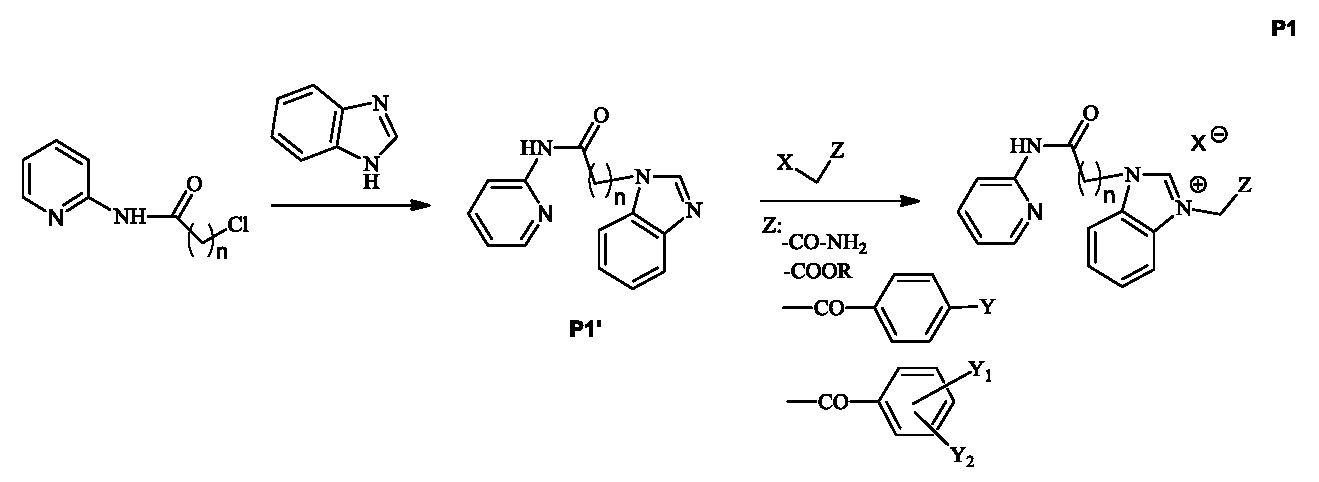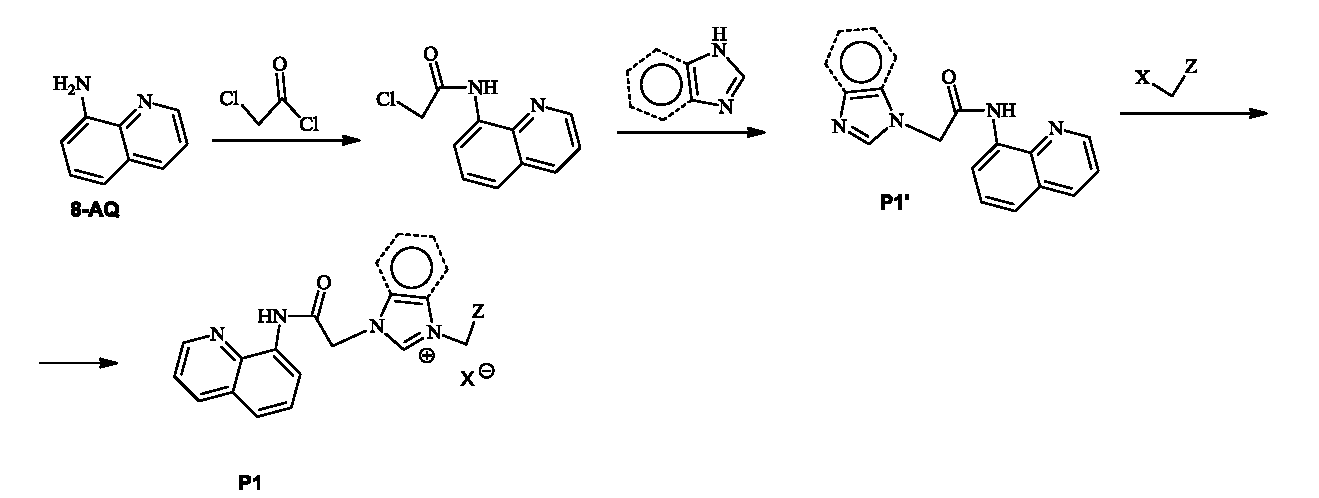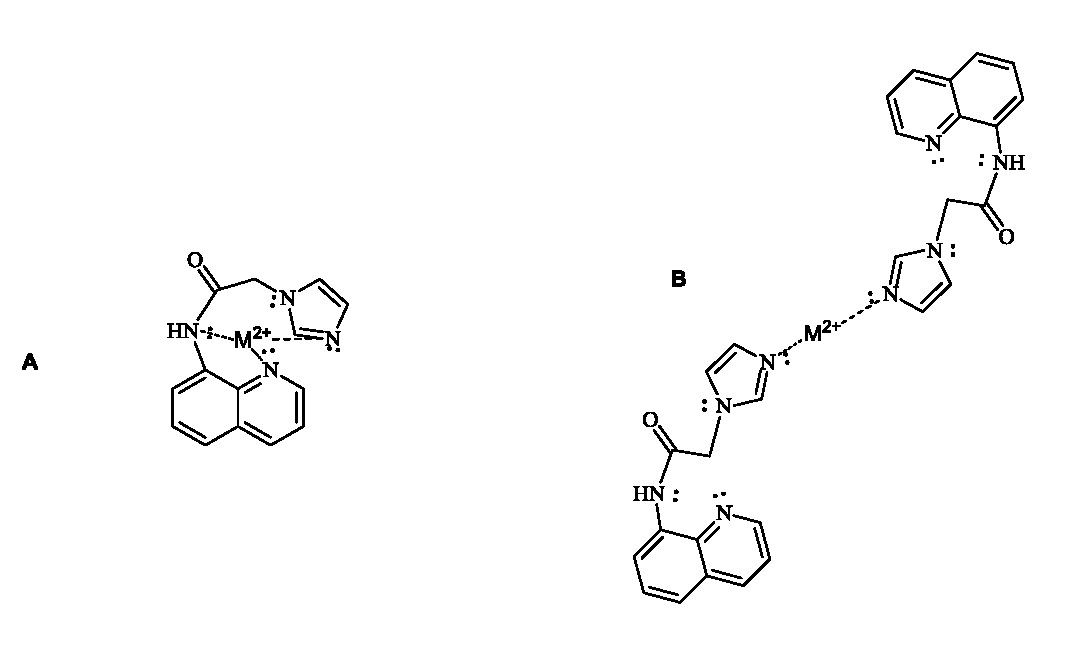4th Stage Report
2015. Stage IV. Synthesis and structural analysis of macrocycles and podant derivatives
In this stage there was brought contributions to objectives O3-O7.
A.IV.1. Synthesis of the necessary intermediary
There was accomplished as we described in stage I, A.I.1.
A.IV.2. Synthesis of new nitrogen podant type P1 having in the same molecule at a π–reach and a π–deficient heterocycle connected via different spacers.
The main objective of this stage was the synthesis of new nitrogen podants type P1, having in the same molecule a π–reach nitrogen heterocycles and π–deficient nitrogen heterocycles. The two type of nitrogen heterocycles have been connected via an alkyl spacer.
The synthesis of the new nitrogen podants type P1 have been performed using a straightforward and efficient way of synthesis, which involve 2 steps:
- the first step involve an alkylation reaction of benzimidazole with pyridine derivatives having an activated halogen atom, which are leading to the podants derivatives type P1’, having into the same molecule one unit of pyridine (π–deficient nitrogen heterocycles) and one unit of benzimidazole (π–reach nitrogen heterocycles);
- in the second step the podants derivatives type P1’ suffer a quaternization reaction (via a N-alkylation reaction) with variously compounds having an activated halogen atom, leading to the podants derivatives type P1, having into the same molecule a π–deficient nitrogen heterocycles and a π–reach nitrogen heterocycles as we described in the reaction scheme bellow:

The synthesis of another class of new nitrogen podants type P1 have been performed, using 8-amino-quinoline a starting material, using a straightforward and efficient way of synthesis, which involve 3 steps:
- the first step involve an acylation reaction of 8-amino-quinoline with chloro-acethyl chloride, when the corresponding acylated 8-AQ derivative are obtained;
- the second step involve an alkylation reaction of imidazole or benzimidazole derivatives with the acylated 8-AQ derivative (having an activated chlorine) atom, which are leading to the podants derivatives type P1’, having into the same molecule one unit of 8-amino-quinoline (π–deficient nitrogen heterocycles) and one unit of imidazole or benzimidazole (π–reach nitrogen heterocycles);
- – in the third step the podants derivatives type P1’ suffer a quaternization reaction (via a N-alkylation reaction) with variously compounds having an activated halogen atom, leading to the podants derivatives type P1, having into the same molecule a π–deficient nitrogen heterocycles (one unit of 8-amino-quinoline) and a π–reach nitrogen heterocycles (one unit of imidazole or benzimidazole) as we described in the reaction scheme bellow:

The reactions were performed under conventional TH, US and MW irradiation. Comparative studies TH versus US and MW irradiations have been performed and, hypotheses concerning the efficiency of these setup procedure have been formulated.
In the next step, podants P1 and P1’ was tested as chemosensor (complexation with metals, Mm+) and also was tested their ability to function as compounds with antimicrobial and anticancer activity (see also A.IV.3). Some of the complexes of podants P1 and P1’ have fluorescence.
The complexation ability of P1 was tested using some bivalent metals, copper and zinc, and the corresponding complexes was obtained. The most probable, two complexation process could be taken into consideration:
- an intramolecular complex (structure A), when the nitrogens from quinoline, imidazole (N3) and amide one are involved;
- an intermolecular complex (structure B), when the nitrogens N3 from imidazole are involved;

Until now we did not realize to obtain suitable monocrystals in order to prove unambiguously the structure.
A.IV.3. Evaluation of the biological active properties
Some of the newly obtained compounds was tested as potential antimicrobials and antitumoral drugs.
The antitubercular activity of the synthesized podants type P1 and P1’ were evaluated. Compounds were evaluated for antimycobacterial activity against Mycobacterium tuberculosis, as a part of the TAACF TB screening program under direction of the US National Institute of Health, the NIAID division. Antimycobacterial activities of the compounds were performed by Center of Tuberculosis Antimicrobial Acquisition and Coordinating Facility (TAACF) at Southern Research Institute.
The antitubercular tests indicate that some compounds are potent inhibitors against M. tuberculosis, one podant with pyridine skeleton from the class P1 being selected for Cycle-2 screening assay. Thus, these compounds have a remarkable activity against both replicating and non-replicating M. tuberculosis, both in aerobic conditions [MIC (mM) around 50-100, IC50 (mM) between 40 and 100, IC90 (mM) between 50 and 150] and anaerobic conditions [MIC (mM) around 150, IC50 (mM) around 25, IC90 (mM) around 60 si 90]. The compound selected for Cycle-2 have proved to be active against resistant strains of Mycobacterium tuberculosis [MIC (mM) >50, pt INH-1, INH-R2, RIF-R1, RIF-R2, FQ-R1] and also have no toxicity. Interesting SAR correlation could be described.
The antitumoral activity of some compounds were evaluated in vitro and screened against human cervix epithelial carcinoma cell line (HeLa), some of the compounds having a promising antitumoral activity. A selection of compounds podants type P1 and P1’ was selected and tested in vitro for anticancer activity by the National Cancer Institute (NCI, USA), under the Developmental Therapeutics Program (DTP), at a single high dose [10-4 M] cell assay. This assay was performed in a 60 human tumour cell line panel, representing leukemia, melanoma and cancers of lung, colon, brain, breast, ovary, kidney and prostate, in accordance with the protocol of the NCI. Results for each compound were reported as a Mean Graph of the growth percent of the treated cells when compared to the untreated control cells and is available for analysis by the COMPARE program. The results was leading to the following conclusions:
- The azapodants type P1 and P1’, have a significant anticancer activity against the following tumour cells: Brest cancer, Leukemia, Non-Small Cell Lung Cancer, Melanoma, Renal Cancer;
- The azapodants type P1 and P1’ containing a benzimidazole skeleton, have a much significant anticancer activity comparative with the imidazole one;
- We did not see any significant difference concerning anticancer activity between azapodants containing quinoline or pyridine skeleton.
A.IV.4. Elemental and structural analysis of the obtained structures. Final stage report
The structure of the newly compounds was proven through elemental and structural analysis: IR, NMR, UV-Vis and fluorescence, MS, X-ray.
A final stage report was accomplished and it was presented on the web page of the project.
Achievements
- Results Disseminations
Papers published: 1
- Ciobanu, C.; Antoci, V.; Mantu, D.; Mangalagiu I. I.: One Pot Synthesis of Cyclophane with Imidazolium Skeleton. An Improved Method , Rev. Chim.-Bucharest, 66(4), 497-498, 2015. Publisher: SYSCOM 18 SRL, CODEN: RCBUAU ISSN: 0034-7752. ROMANIA. ISI-0.81
Papers presented to Scientific Meetings: 5
- Mangalagiu, I.I. Azaheterocycles as intelligent building blocks, NanoMathChem2015, November 12‐14, 2015. Cluj, Romania. P.L-3, pag.5 (plenary lecture). http://www.esmc.ro/#!nanomathchem2015/c6ve
- Mangalagiu, I.I. New polifunctional nitrogen derivatives as smart versatile building blocks for multiple tasks, Joint COST Action CM1307/2nd Conference / WG2 and WG3 Meetings, October 26-28, 2015, Belgrade, Serbia. P.L-4, pag.13 (plenary lecture). www.costcm1307.org/CM1307_2/2-nd_Meeting.html
- Antoci, D. Mantu, Ghe. Zbancioc, C. Moldoveanu, Mangalagiu, I.I. Complexation of anthracene-imidazolium salt with different acetate ions: UV-vis and fluorescence studies, “Al.I.Cuza“ University Days, October 29 – 31, 2015. Iasi, Romania. Poster P24. ISSN 2067 – 2438; ISSN (online) 2067 – 2446. http://aci.chem.uaic.ro (Supplement of the Acta Chimica Iasi journal)
- Mangalagiu, I.I.: Smart Synthetic Azaheterocycles, ”The 18-th International Conference “Physical Methods in Coordination and Supramolecular Chemistry””, Chisinau, 8 – 9 Octomber 2015. L-11: plenary lecture, pag. 11. ISBN 978-9975-71-692-5. http://chem.asm.md/iccsrm
- Mantu, D.; Antoci, V.; Puscasu, R.; Mnagalagiu, I.I. New polifunctional nitrogen derivatives (heterocycles / podants) as smart versatile building blocks for multiple tasks, European Exhibition of Creativity and Invovation, Euroinvent 2015, May 16-18 2015, Iasi, Romania. Class: Inovative Research, pag. 238. Poster, ISBN 978-606-714-037-8. http://eudirect.ro/euroinvent/
Awards
- <liMay 16-18, 2015. “Gold Medal”, Paper awarded: “New polifunctional nitrogen derivatives (heterocycles / podants) as smart versatile building blocks for multiple tasks”. Euroinvent 2015, Iasi, Romania;